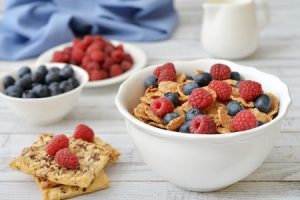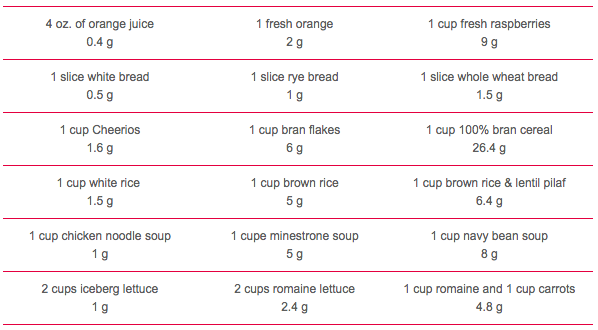FiberTastic… FiberLicious… FiberHealthy
If you’ve ever read any of my books, watched my TV show or heard me speak, you know that I live by my mantra of the “Power of One Good Habit.” In fact, one specific habit that I just can’t promote strongly enough can actually help you:
 reduce your risk of colon and rectal cancer by 56%
reduce your risk of colon and rectal cancer by 56%- lower your risk of heart disease by 40%
- help fight obesity, type 2 diabetes and constipation
Interested?? Thought you would be! Drum roll please …
Eat 30 grams of fiber each and every day.
That’s right, diets naturally high in fiber help prevent colon and rectal cancer, heart disease, type 2 diabetes, obesity and constipation.
Just a second, though. When I say diets naturally high in fiber, I’m not talking about getting fiber from supplements. You won’t get the same benefits from 30 grams of fiber supplements that you get from foods naturally high in fiber. That’s because when you get 30 grams of fiber from foods, you receive the synergistic benefits of fiber PLUS phytochemicals and antioxidants as well as high water content.
But wait another second … isn’t fiber only important for older people? No. Statistics show that even children aren’t getting the amount of natural fiber they need. Studies also show that even though most of us know that fiber is important in our daily diet, Americans average only 11 grams each day. Shame on us!!
The poop on fiber
The easiest way to think about fiber is to imagine it as the essential exercise for the walls of your intestines. Remember that every time you eat, your food travels 24 feet from your mouth to your “other end.” And the inside walls of your GI tract are actually muscles that need to keep in shape so your digestive system works the way it should. Fiber gives these muscles the workout program it needs to cleanse your intestinal tract, keep you “regular,” soak up bad cholesterol and keep your colon healthy.
Besides keeping the muscles of your intestinal walls in shape and providing an excellent cleaning service for your colon, foods naturally high in fiber are loaded with beneficial phytochemicals and antioxidants. High-fiber foods also contain more bulk and higher water content with fewer calories, which means we get full faster while eating less.

What exactly is fiber?
Fiber is the portion of plant foods that the body does not digest, or in other words, the roughage. It is not found in any animal foods.
| Yes | No |
|---|---|
| Plant | Animal |
| Fruits | Chicken |
| Vegetables | Beef |
| Grains | Pork |
| Whole-grain flours | Veal |
| Whole-grain baked goods | Fish |
| Dried beans and peas | Milk |
| Nuts | Cheese |
| Seeds | Eggs |
Plant foods should cover two-thirds of your plate (vs. the traditional two-thirds covered with meat)
Two kinds of fiber
When people think of fiber, the first things that come to mind are leaves and twigs. Not quite. There are actually two kinds of fiber. The first is the insoluble or scratchy kind like nuts and seeds and fruits and vegetables. This is the “rotor-rooter” stuff that works to keep your colon clean. In fact, I like to think of broccoli as little colon brushes keeping the walls of my colon from collecting unwanted debris. The second kind of fiber is the soluble or spongy kind like oatmeal and dried beans. These work like little sponges to soak up nasty cholesterol and then our body poops it out. So if you need to lower your cholesterol, make sure you include beans in your menu four times a week.
Four simple steps to EASILY get your 30 grams a day
Now that you know WHAT foods constitute fiber, just how can you make sure you’re getting 30 grams a day in your diet? Here are four simple steps that can make this habit an easy one to master:
- Eat 3 or more pieces of fruit each day (keep a giant fruit bowl filled and on your counter for “in sight/in reach” access)
- Eat 3 or more ½-cup servings of vegetables each day (snack on fresh veggies before dinner, double your “token spoonful” at dinner and eat a giant salad for lunch)
- Eat 4 or more servings of whole-grain breads, cereals and pasta, brown rice and oatmeal each day (trade your wimpy white bread and pasta for fiber-rich whole-grain and make Scrumptious Swiss Oats ‘n Fruit for breakfast)
- Eat beans 4 times a week (add garbanzo beans, kidney beans or peas to your salad, serve hummus or bean dip instead of sour cream dips and make Lickety-Split Meals recipes like Spanish Red Beans & Rice (page 153) or Hearty Bean & Pasta Stew(page 223). Also try my Eat REAL Cookbook which provides four weeks of menus that include 2 to 4 bean dishes weekly.
Choose RIGHT for more fiber!

